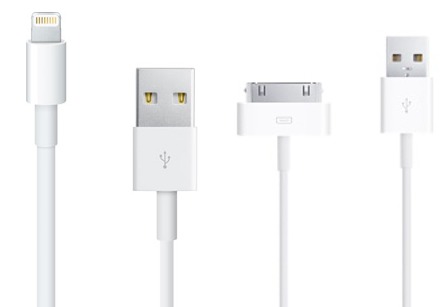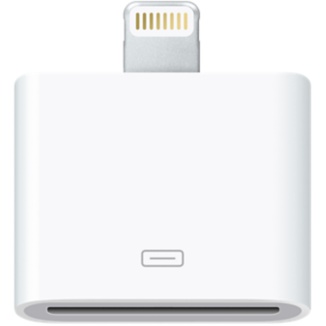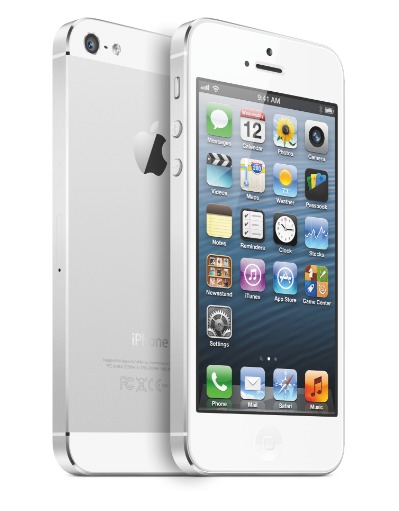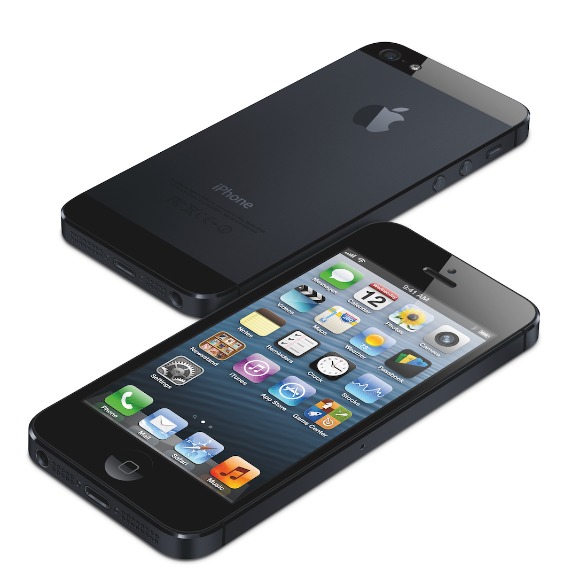iPhone 5: Taller, Faster, and More Pixels
Following what has become a familiar script, Apple unveiled a new iPhone at a special media event on 12 September 2012. The new model, which Apple is thankfully calling the “iPhone 5” rather than “the new iPhone,” became available for pre-order on September 14th and will start shipping a week later on September 21st. Pre-orders exceeded two million units in the first 24 hours, more than double the previous record set by the iPhone 4S, and since demand outstripped Apple’s initial supply, many pre-orders won’t be delivered until early October. Pricing remains the same, at
$199 for 16 GB of storage, $299 for 32 GB, and $399 for 64 GB — all prices assume a two-year cellular contract.
Industrial Design and New Display — Whereas the iPhone 4S shared the same industrial design as the iPhone 4 (as did the 3G and 3GS), the iPhone 5 debuts in a new form factor that’s slightly taller and thinner, and noticeably lighter. Specifically, it’s 7 percent taller (4.87 inches/123.8 mm versus 4.5 inches/115.2 mm for the iPhone 4 and 4S), the same width (2.31 inches/58.6 mm), 18 percent thinner (0.30 inches/7.6 mm versus 0.38 inches/9.3 mm), and 20 percent lighter (3.95 ounces/112 grams versus 4.9 ounces/140 grams).
The added height is necessary to accommodate the new 4-inch (diagonal) Retina display; all previous iPhones have sported 3.5-inch displays. Instead of being proportionally larger, the iPhone 5’s screen boasts more vertical pixels with a resolution of 1136 by 640, up from 960 by 640. Apps will have to be rewritten to take advantage of the extra pixels — those that aren’t will be letterboxed with black bars on the top and bottom of the screen. Apple’s apps have been updated — with Pages, Keynote, Numbers, iMovie, and GarageBand being called out in particular.
The most immediate thing you’ll notice, though, is that the main iPhone screen now has room for five rows of icons instead of just four, which should make it just a little easier to navigate for people with lots of apps.
Although the specs for brightness and contrast remain the same, Apple claimed that the new display has 44 percent better color saturation and because the touchscreen is integrated into the display, it will be sharper and suffer less from glare in sunlight.
Perhaps more significant is the new connector that replaces the hoary dock connector that we’ve become so accustomed to with the iPod, iPhone, and iPad. Called Lightning, the new all-digital connector is both thinner and smaller — Apple claims 80 percent smaller. The most welcome change is that it’s reversible, so it won’t matter which side is up when you try to plug in your iPhone. Apple also claims it will be more durable.
The problem, of course, is that we all have multiple dock connector cables strewn throughout our homes and offices, so it’s easy to plug in any iPod or iOS device. And worse, numerous speakers, docks, car adapters, and the like all rely on the dock connector. Apple isn’t leaving us in the lurch, but you’re not going to like the solution: an adapter that looks tremendously awkward. The adapter is available as a $29 single
standalone piece or as a $39 0.2 meter cable.
As with previous models, the iPhone 5 comes in two colors: black and white. But it’s not quite the same as before, since the black model has a black anodized back, whereas the white model features a raw aluminum back. In either case, the metal back should prove more durable than the glass back in the iPhone 4/4S.
Ultrafast Wireless — “Ultrafast” is Apple’s term, not ours, but the iPhone 5 sports two notable improvements to its wireless networking capabilities. First is support for LTE, which comes on top of the previously supported alphabet soup of cellular data protocols. When supported by cellular carriers, LTE offers up to 100 Mbps of downlink bandwidth, more than twice as much as DC-HSDPA (42 Mbps) and almost five times as much as HSPA+ (21 Mbps). What actual difference this will make in real-world usage undoubtedly depends hugely on specific situations, but it seems safe to say that downloading can be much faster. Those with limited data plans may wish to be careful,
since it will be possible to suck down more data more quickly than in the past.
LTE band support varies by country, so there are actually three versions of the iPhone 5, a GSM model sold in the United States and Canada, a CDMA model sold in the United States and Japan, and a GSM model that works in European and Asian countries (the CDMA model and this GSM model are physically the same, but differ based on how they’re activated). As a result, if you buy the GSM iPhone on sale in the United States and Canada, it won’t work on most LTE networks worldwide. The CDMA model of the iPhone 5 available in the United States and Japan does supports the LTE bands used in other countries, however. (For many more details on this topic, see “Which iPhone 5 Lets You Roam Where You Want?,” 13 September 2012.)
The other useful wireless change is support for 802.11n in both the 2.4 GHz and 5 GHz bands. Although both the iPhone 4 and 4S supported 802.11n, they did so only in the 2.4 GHz band, forcing everyone with iPhones to keep 2.4 GHz active on their networks even if it might otherwise have worked better to rely on 5 GHz. It probably isn’t safe for any network used by multiple people to turn off 2.4 GHz, but it’s at least now possible for specific situations. Plus, the iPhone 5’s dual-channel support in the 5 GHz band has the potential to increase throughput when on an appropriately configured Wi-Fi network.
It’s worth noting that the CDMA model of the iPhone 5 for use with Verizon Wireless still won’t support simultaneous voice and data, even when used on Verizon’s LTE network. The problem apparently has to do with the iPhone 5 lacking a third antenna to handle LTE data at the same time as voice, according to Brian X. Chen at the New York Times.
A6 Processor — Providing processing power for the iPhone 5 is the A6 chip, Apple’s custom-built successor to the A5 chip that powers the iPhone 4 and 4S, the iPad 2 and third-generation iPad, and the forthcoming fifth-generation iPod touch. Apple continues to rely on its own chip designs instead of incorporating a CPU from an outside chip developer, as most other smartphone vendors do.
The new A6 has a CPU that doubles the speed of the previous model, and that provides double the speed of graphics processing as well. At the same time, the chip is 22 percent smaller than the A5, freeing up room for the other components within the thinner iPhone 5 housing.
Apps should show marked improvement in performance with this new chip and should launch faster as well. In the presentation, Apple noted that Pages launches over twice as fast on the new processor and Keynote launches 1.7 times faster.
The ramped-up processing power also benefits the camera and audio systems in the iPhone 5. The chip has a new image signal processor that helps the camera perform better noise reduction in images, handle low-light situations better, and capture images as much as 40 percent faster (see below). The improved noise-canceling and voice-recognition capabilities (Siri, can you hear me now?) and the new wideband audio feature for phone calls, which makes the sound on phone calls richer, all make use of the advanced signal processing power of the chip as well. Note, however, that wideband audio requires carrier support; we’ll be interested to discover which carriers provide it, and in which countries.
iSight Camera — When the iPhone 4S was introduced last year, we knew people who were excited to buy a high-quality digital camera that also happened to work as a phone. Having a good camera with you at all times makes a huge difference in being able to capture the photos you want, and the iPhone 4S fit the bill.
The iPhone 5 makes small improvements to the camera hardware. It captures photos with 8 megapixels of data at a resolution of 3264 by 2448 pixels, using a backside-illuminated sensor, the same as the iPhone 4S. The lens is made up of five elements; it includes an infrared filter; and it features an aperture of f/2.4. Video records at 1080p, also just like the iPhone 4S. However, although this doesn’t matter to consumers, it’s worth pointing out that these specs now come out of an assembly that’s 25 percent smaller.
If your current iPhone’s camera now shoots Instagram-style photos by default due to a scratched lens, you’ll be happy to hear that the new camera is covered by hard and clear sapphire crystal.
Where the iPhone 5’s iSight camera improves on its predecessor is in the software and the A6 processor at the heart of the device. A dynamic low light mode improves capture of dimly lit situations, evaluating nearby pixels to give up to two f-stops of better low-light performance, and Apple claims that noise reduction is improved. A smart filter feature also analyzes the scene and determines how much noise reduction should be applied, which areas need uniform color, and other aspects.
Better still, it boasts 40 percent faster image capture, reducing the dreaded shutter lag that plagues most digital cameras.
As you’d expect, Apple has posted an iPhone image gallery showing off photos unedited from the device.
One brand new feature is Panorama, which captures panoramic photos as you move the phone horizontally. The software guides you and stitches images together as the panorama is captured, with up to 240 degrees of rotation.
The iPhone 4S also added 1080p video recording to the iPhone’s capabilities. In the iPhone 5, image stabilization is improved, and face detection can identify up to 10 people in the frame as focus points. Apple says that you can also snap photo stills while recording video without disrupting the video capture, which is very neat.
The front-facing camera is now improved with 720p resolution to take advantage of FaceTime video conferencing, which will now work over cellular connections (provided the feature is allowed by cellular carriers — we’re looking at you, AT&T).
Although not specific to the cameras themselves, Apple touted the new Shared Photo Stream feature of iCloud and iOS 6. No longer will your Photo Stream be limited to just your devices. You’ll be able to share photos with friends, and they can comment or mark photos as favorites.
Sound — Previous versions of the iPhone had two microphones: one on the bottom, used for phone calls and other voice input, and another on the top used for capturing ambient sound as part of the phone’s noise-canceling capabilities and for capturing video. (See “Where to Speak on Your iPhone 4,” 21 March 2012.) The iPhone 5 features three microphones: the traditional bottom mic, and one each on the front and on the back which can help in both speakerphone mode and for FaceTime use, as well as for providing additional audio input for noise reduction. The three microphones also allow the iPhone to triangulate on the main
audio source dynamically, so that phone calls from crowded noisy rooms should sound better at the other end. We can’t wait to see if that’s true.
The iPhone 5’s internal speaker is both smaller and more powerful than that in the iPhone 4S. The speaker’s transducer uses five magnets (Apple must have a lock on the world’s magnet supply at this point) and, according to Apple, produces a better frequency response than its predecessor while being 20 percent smaller.
The iconic earbuds are gone. In their place are EarPods, earphones that look like tiny alien eggs and that have been designed to fit better in the ear — Apple says its designers scanned hundreds of different shaped ears to come up with the design over a three-year period (Hear Different?). The EarPods also incorporate a microphone that feeds into the iPhone 5’s noise-canceling capability, the first time that Apple-supplied earphones have supported the iPhone’s noise-cancellation feature.
When, Where, and How Much? — The iPhone 5 keeps the same pricing as last year’s iPhone 4S: $199 for 16 GB of storage, $299 for 32 GB, and $399 for 64 GB (those are subsidized prices with cellular contracts). Although Apple isn’t currently showing these prices on their site, TechCrunch took a screenshot of the Apple site showing unlocked pricing of $649 for 16 GB, $749 for 32 GB, and $849 for 64 GB, and those prices seem likely, since they’re the same as they were for the iPhone 4S. No-contract pricing from AT&T and Verizon is identical.
The iPhone 4S remains available in just the 16 GB capacity, and drops to $99 with a contract. The iPhone 4, also in the 16 GB model, is now free with a contract, replacing the iPhone 3GS, which disappears. All models are available in black or white.
Shipping and in-store pickup begin September 21st in the United States, Canada, United Kingdom, Germany, France, Australia, Japan, Hong Kong and Singapore. On September 28th, 22 more countries will join the list, including Austria, Belgium, Czech Republic, Denmark, Estonia, Finland, Hungary, Ireland, Italy, Liechtenstein, Lithuania, Luxembourg, Netherlands, New Zealand, Norway, Poland, Portugal, Slovakia, Slovenia, Spain, Sweden and Switzerland. If you’d rather have the Apple Store lineup experience, in-person sales begin at 8:00 AM on September 21st.




" In short, you won’t want to buy an iPhone in the United States and expect to use it with LTE in Europe."
It looks like the Verizon/Sprint model is a superset of the ROW model. It has all of the 3G and LTE bands on the ROW model plus CDMA.
That's correct. You can ask Verizon (after 60 days with previous iPhone models, I believe) to unlock the GSM slot and then use any compatible one. However, the nano-SIM format is new, so it might be a pain to get one in other countries.
The Verizon model has the three LTE world bands and the two Verizon LTE bands along with 3G CDMA (and ostensibly an unlisted 2G 1xRTT because Verizon still relies on that for voice) and all the GSM 2G/3G bands!
Good catch - I've tweaked the article. There are tradeoffs no matter what model you choose.
• AT&T iPhone 5 can't use LTE outside the U.S. and Canada.
• Verizon iPhone 5 can't be used on GSM networks in the U.S.
• International iPhone 5 can't be used on AT&T's LTE network.
You note that the new Lightning connector is an all-digital connection, but also that apple offers adapters because we all have "cars, radios, docks, ..." which have dock connectors. But many people's cars, radios, docks make use of an analog connection for audio and (sometimes) even video. Will the new, expensive, adapter enable me to still play audio in my car or use my old, also expensive, iphone to TV adapter? Or do all of these accessories just now become fancy chargers? In which case I'd be financially better off buying a 12-pack of charge cables rather than half-a-dozen adapters. Oh, and a new car with A2DP bluetooth. :)
We'll know more when these things actually ship! Certainly, the implication is that the adapter will just let you use your old cable or dock just fine, assuming the physical constraints don't get in the way.
The Lightning to 30-pin adapter supports analog audio output and USB audio (whatever that is). It does not support the "iPod Out" feature which I guess would let you control an iPod using controls built into your car.
http://store.apple.com/us/product/MD823ZM/A/lightning-to-30-pin-adapterbr />
The adapter does not support video output but it has been reported elsewhere that Apple will be releasing Lightning adapters equivalent to their 30-pin to VGA and HDMI adapters.
Interesting and thanks for the detail. That's good news - and better than I expected - I guess the digital to analog conversion part of the adapter is part of what causes such a high cost.